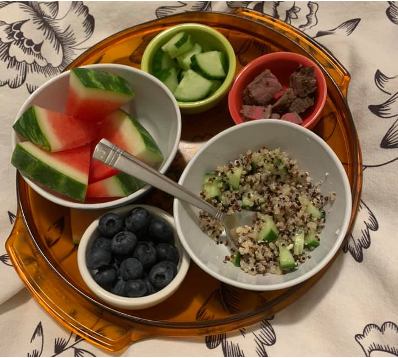Article
Tiny Dishes and Silent Persistence: How I Got My Daughter to Eat During Cancer Treatment
Author(s):
As a caregiver to my daughter with breast cancer, I had to get creative in finding ways to help her keep food down after treatments made her nauseous.
One of the things I “knew” from my media exposure to cancer treatment was that chemotherapy can cause loss of appetite, nausea and vomiting. In the beginning I thought all treatment options caused that and I learned along the way that there are some that not only don’t cause those particular side effects, but the steroids used along with the treatment can cause the patient to be ravenously hungry.
My daughter Adrienne’s chemotherapy was four sessions of the former, the treatment many breast cancer patients affectionately call the “Red Devil,” and twelve sessions of the latter, Taxol (paclitaxel).
We knew going in what she would be facing with the Red Devil, both from what was shared by the oncology team and also from doing our own research. We were told by the doctor that it was really important for her to try not to lose weight since the treatment is formulated based on how much a person weighs, so keeping her iron up would be significant since her blood health could be negatively impacted by the chemotherapy.
I don’t think either of us had any idea how big an ask that would be until treatment started.
As Adrienne’s mother and caregiver, nurturing her with food was a natural process and it helped me immensely because I felt like I could DO something. I had quite a bit of experience with constant nausea and vomiting from the morning sickness I experienced with all of my pregnancies, so I had a bit of an edge going in when planning what and how to feed her.
We went grocery shopping together before the first treatment cycle, picking up things that she thought might appeal and things that had helped me get some calories in.Of course all of this preparation was speculation because we had no idea what she would be able to tolerate, so the hodgepodge of things in our house ranged from quinoa to blueberries to pudding to potato chips.
After the first cycle we went home and just waited. Waited to see when and how much the side effects would impact her. And after a couple of hours, it came.
Despite the three anti-nausea medications she was given, the nausea still came. She sat very still, not willing to move because motion made it worse. We kept the house as cool as we could get it because that seemed to help. She added in the CBD oil she had been prescribed and it eased it, but it was still there.
Yet despite how she was feeling, I knew I needed to try to get her to eat. So this is what I did.

The biggest of those dishes is three inches across. The spoon is a little baby spoon.I cut all of her food into tiny pieces just like when she was little. Instead of asking her what she wanted to eat, I made up plates like this and just put them beside her. If she ate, she ate. If she didn’t, I tried something different a few hours later. We quickly learned after the first cycle that cooking smells were the enemy, so for the following cycles, in the second week when things had eased up, I would prepare food ahead of time. I tried for cool crispness as much as I could.
There was no conversation, no cajoling. She is a grown woman and didn’t need her mother nagging her to eat something. She had been in the same room as I had when the oncology team talked about the importance of trying. I would silently deliver the options, and just as silently take them away. The sorrow or joy I would experience depending on how much she had been able to choke down was my secret to keep.
Adrienne told me later that this was one of the things that helped her the most. Not asking, just doing. I have heard many patients with cancer say the same thing. I was never offended if she didn’t eat anything since her eating was not about me. So my advice to caregivers out there is that if at first you don’t succeed, try, try again.
And buy some very small dishes.
For more news on cancer updates, research and education, don’t forget to subscribe to CURE®’s newsletters here.





